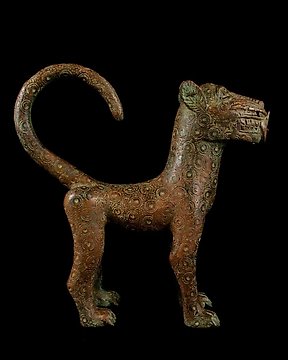
Leopardo de bronze - Bini/Edu - Nigéria
N.º 84126909

N.º 84126909

An Osun bronze head in the style of Benin...snakes issuing from the eyes and nostrils, and a crown of birds, both creatures being closely associated with Osun. Birds were often sited on the top of palaces and have prophetic and protective powers. In this case the snake on the forehead is associated with lightning and its destructive powers; greenish to ocher different layers of oxidations, several small holes are piering through the metal.
The Osun-Osogbo is a sacred grovealong the banks of the Osun river just outside the city of Osogbo State, Nigeria,
Osun head, British Museum, London (Penultimate photo sequence).
The Osun-Osogbo Grove is several centuries old and is among the last of the sacred forests that once adjoined the edges of most Yoruba cities before extensive utrbanization. In recognition of its global significance and cultural value, the Sacred Grove was inscribed as a Unesco World heritage in 2005.
The 1950s witnessed the desecration of the Osun-Osogbo Grove: shrines were neglected and priests abandoned the grove as customary responsibilities and sanctions weakened. Prohibited actions like fishing, hunting and falling of trees in the Grove was done indiscriminately until an Austrian national named Susanne Wenger (1915-2009)helped to reinstate traditional protections.
With the support and encouragement of the Ataoja (the royal king of the time) and the support of the concerned local people. Wenger "formed the New Sacred Art movement to challenge land speculators, repel poachers, protect shrines and begin the long process of bringing the sacred place back to life by establishing it again, as the sacred heart of Osogbo". Wenger later came to be honoured the titled "Adunni Olorisha" for her custodial efforts and her consistent devotion to the gods of the grove.
A century ago there were many sacred groves in Yorubaland: every town had one. Most of these groves have now been abandoned or have shrunk to quite small areas. Osun-Osogbo, in the heart of Osogbo, the capital of Osun State, founded some 400 years ago in southwest Nigeria, at a distance of 250 km from Lagos is the largest sacred grove to have survived and one that is still revered.
The dense forest of the Osun Sacred Grove is some of the last remnants of primary high forest in southern Nigeria. Through the forest meanders the river Osun, the spiritual abode of the river goddess Osun. Set within the forest sanctuary are forty shrines, sculptures and art works erected in honour of Osun and other Yoruba deities, many created in the past forty years, two palaces, five sacred places and nine worship points strung along the river banks with designated priests and priestesses.
Another Osun bronze, collection Arnd Klinge, which is still (last photo sequence) available on our website.
The new art installed in the grove has also differentiated it from other groves: Osogbo is now unique in having a large component of 20th century sculpture created to reinforce the links between people and the Yoruba pantheon, and the way in which Yoruba towns linked their establishment and growth to the spirits of the forest.
The restoration of the grove by artists has given the grove a new importance: it has become a sacred place for the whole of Yorubaland and a symbol of identity for the wider Yoruba Diaspora.
The Grove is an active religious site where daily, weekly and monthly worship takes place. In addition, an annual processional festival to re-establish the mystic bonds between the goddess and the people of the town occurs every year over twelve days in July and August and thus sustains the living cultural traditions of the Yoruba people.
Lit.: Philip J. C. Dark, An introduction to Benin art and technology, Oxford 1973. Phillips, T. (ed), Africa. The Art of a Continent, 1999. Paula Girshick Ben-Amos, The art of Benin, 1995. Ekpo Eyo, Frank Willett, Kunstschätze aus Alt-Nigeria, Mainz 1983. Barbara Plankensteiner (Hg.), Benin. Könige und Rituale. Höfische Kunst aus Nigeria, Wien 2007. Ezra, Kate. Royal Art of Benin: The Perls Collection in the Metropolitan Museum of Art. Kaplan Flora S. Dr., ed. Images of power: Art of the Royal Court of Benin.
Como comprar na Catawiki
1. Descubra algo especial
2. Faça a licitação vencedora
3. Faça um pagamento seguro